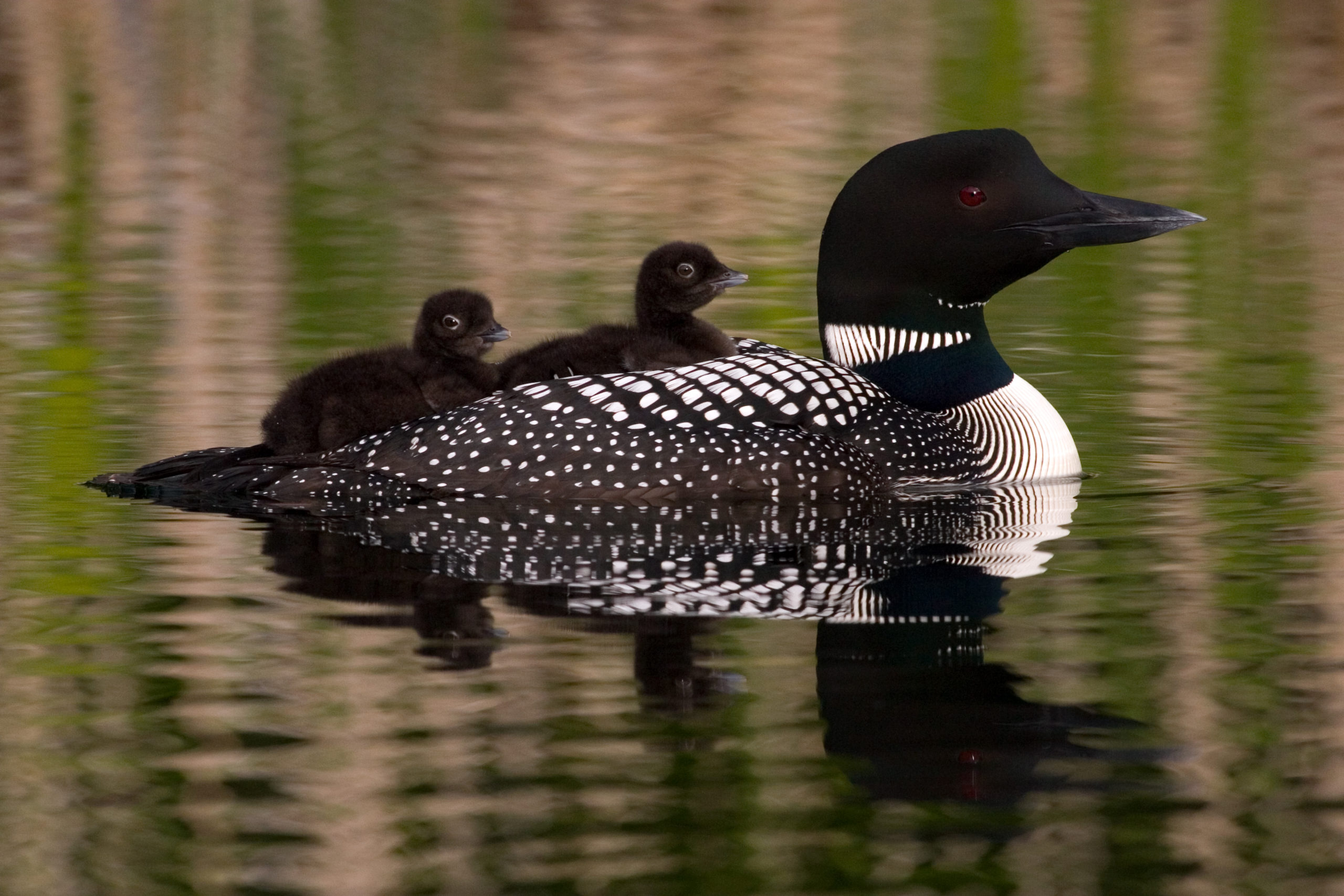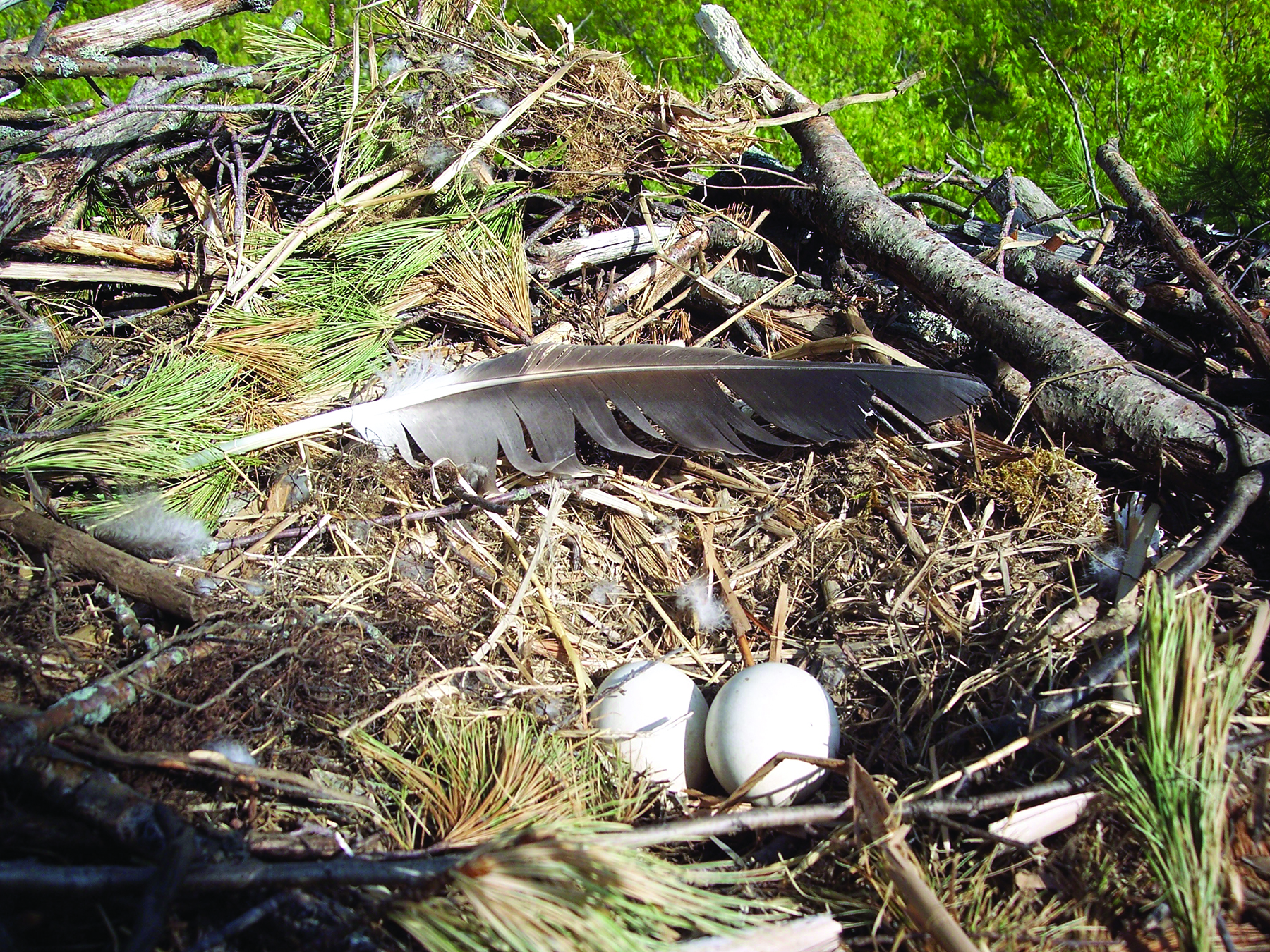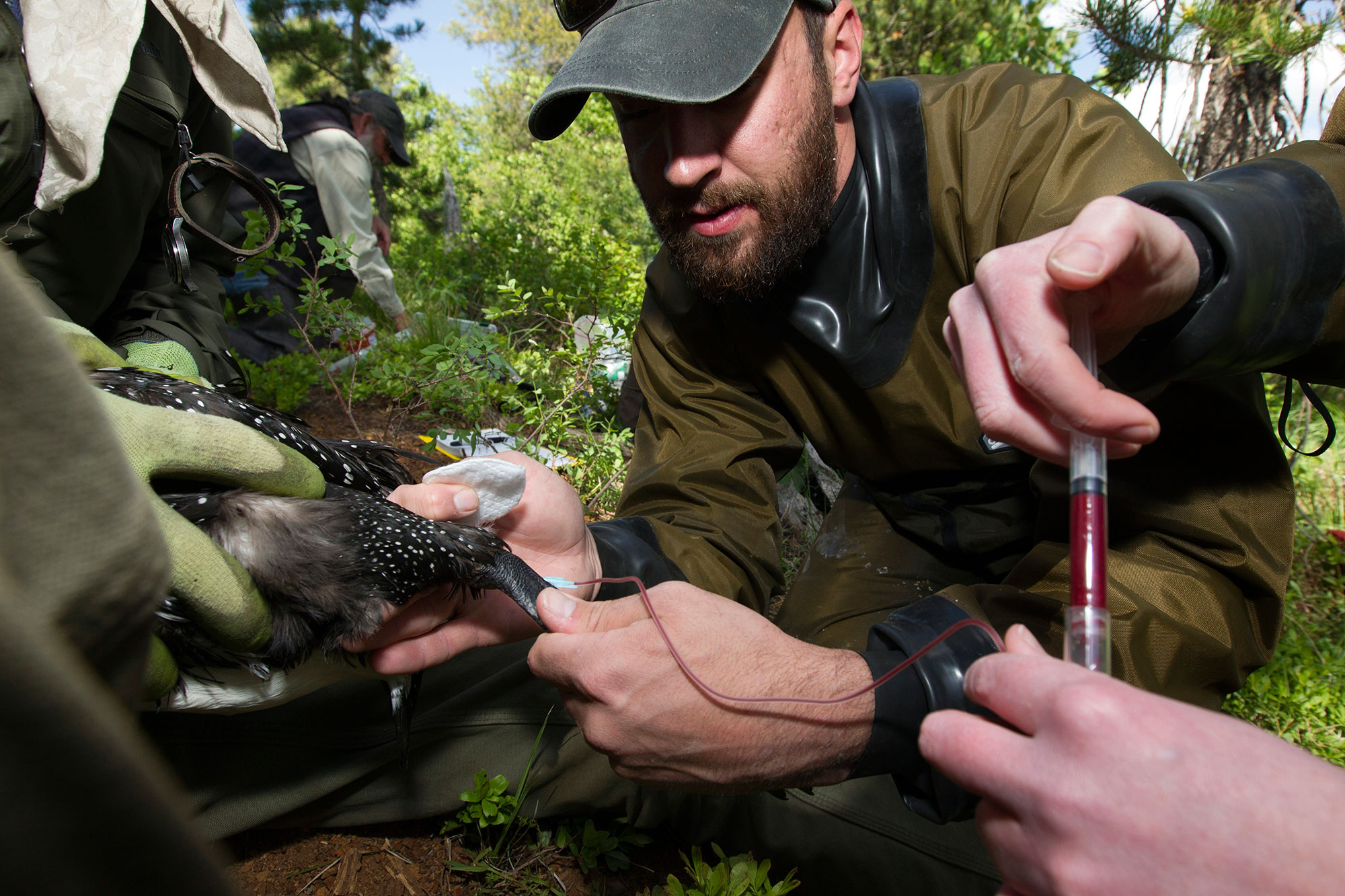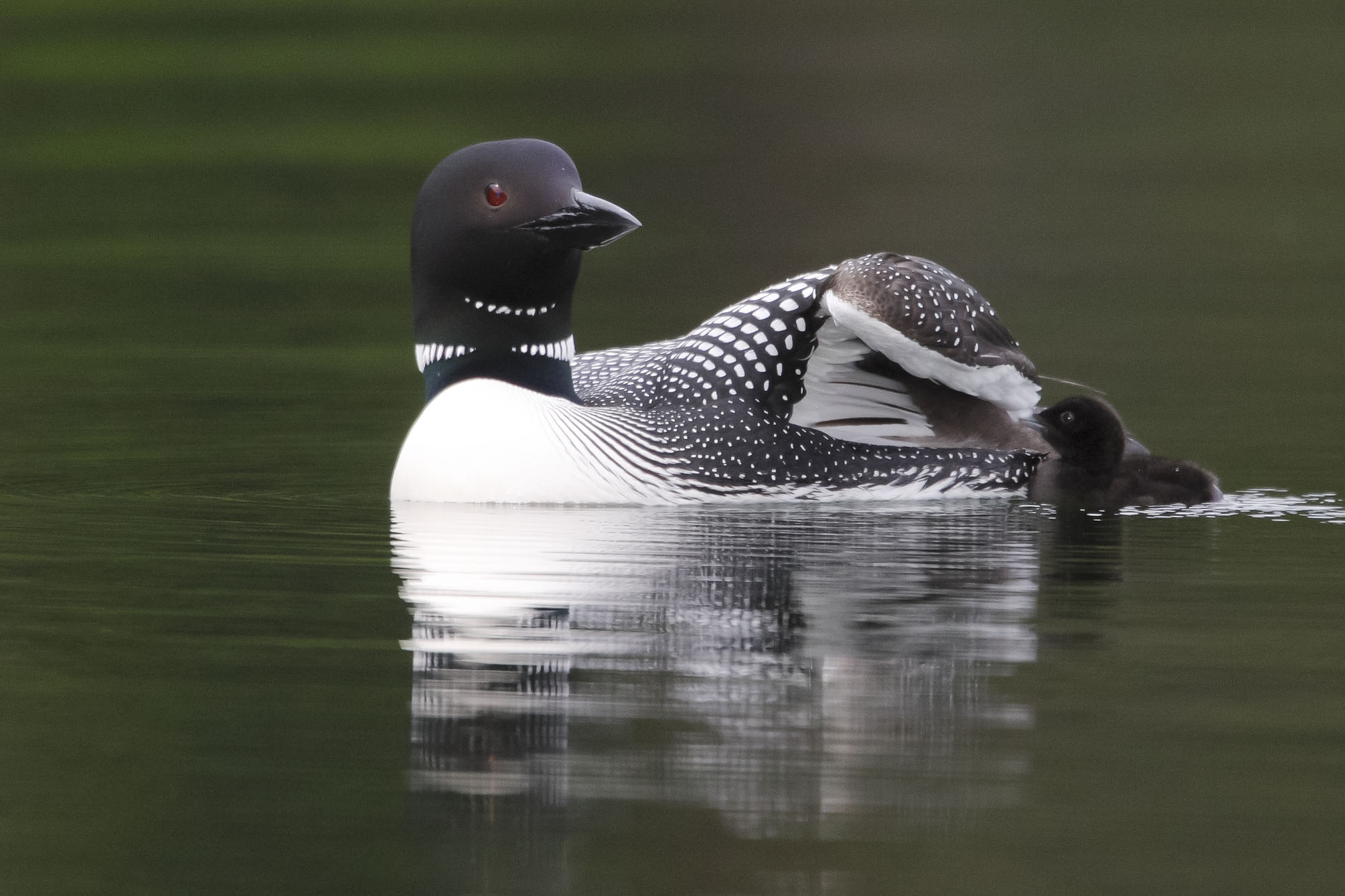Evaluating Mercury and Lead Exposure Risk in Bald Eagles and Common Loons
Project Overview
In 2020, the Mi’kmaq Nation received grant funding from the Tribal Wildlife Grant Program to evaluate the exposure of Bald Eagles and Common Loons to mercury and lead, which threaten both species but have never been studied in northern Maine. The grant also committed to conducting outreach on the health risks of lead and mercury to wildlife and humans, and to expanding the tribe’s capacity to support similar wildlife survey and conservation needs in this region in the future. To conduct this work, Mi’kmaq Nation partnered with biologists from Biodiversity Research Institute (BRI) to capture and collect samples from both species throughout the Fish River Chain of Lakes region.
Download the Science Communication for this project here.
The Fish River Chain of Lakes Study Area
In the northeastern corner of Maine’s Saint John River watershed lies the Fish River Chain of Lakes, a biologically rich waterway comprised of several large lakes interconnected by the Fish River. This region is particularly important to the Mi’kmaq Nation because it lies in the heart of the area in which tribal members have long lived, worked, hunted, and fished. Two species that are noticeably abundant to visitors in this region are two of the most iconic birds in North America: the Common Loon and the Bald Eagle. Both of these long-lived top predators are well-known to be impacted by heavy metals such as mercury and lead.


Mercury in the Environment

Mercury pollution is a local, regional, and global problem that adversely affects ecosystems worldwide—including the northernmost regions of Maine. Globally, more than two-thirds of the mercury currently released into the environment originates, either directly or indirectly, from human activities such as fossil fuel combustion, waste incineration, metal smelting, chlorine production, and discharges in wastewater and other sources.
Once mercury enters an ecosystem, it can be transformed by bacteria into methylmercury, a toxic substance that readily accumulates in organisms throughout the food web. Mercury concentrations tend to be higher in consumers relative to their prey (a process called biomagnification), which puts organisms at the top of food webs—such as Bald Eagles, Common Loons, and humans—at highest risk of accumulating toxic levels of mercury in their bodies over time.
Mercury Impacts on Wildlife Health

Mercury pollution has been documented to negatively affect Common Loons and Bald Eagles. These species are well-established bioindicators used to monitor environmental mercury patterns and effects.
Independent studies found that Common Loons exposed to high levels of mercury produce fewer fledged young than those with low mercury exposure. Similarly, negative correlations between mercury exposure and reproductive success (productivity) have been documented in Maine’s lake-dwelling Bald Eagle population. These findings are consistent with expectations based on other studies and geographic patterns indicating mercury exposure is particularly high in northeastern North America.
Recent evidence suggests that climate-related factors influence patterns of mercury exposure in aquatic and terrestrial biota. Increasing temperature and rainfall, combined with shifting habitat distributions, will shape future mercury deposition and methylation, and in turn, exposure risk. Understanding how these large-scale factors will play out on smaller spatial and temporal scales will require continued research and monitoring.
Lead and the Environment

Lead is a naturally occurring high-density metal that is extracted from ores and refined into a soft, malleable material. Due to its unique physical properties, lead has been incorporated into a wide variety of common household and industrial products including gasoline, electronics, plumbing hardware, cosmetics, and paint. When ingested in even tiny amounts, lead can cause a wide variety of neurological and physiological problems, particularly if exposure occurs during development.
Common Loons and Bald Eagles, two of the most well-established bird bioindicators, are significantly impacted by lead; however, their exposure pathways are notably different. These species demonstrate two primary paths in which lead impacts wildlife. These pathways are also relevant when evaluating several avenues of potential exposure in humans.
Lead Exposure in Common Loons

A leading cause of mortality in loons is lead toxicosis; lead poisoning was responsible for nearly half of the documented mortalities of adult loons in New Hampshire between 1989-2012—a loss estimated to reduce the statewide loon population by 43 percent during that period.
Common Loons and other waterbirds are exposed to lead when they swallow lead fishing weights, either from the lake bottom where loons mistakenly pick up lost lead sinkers to aid in mechanical grinding of food in their gizzards and/or prey fish that have either swallowed or are trailing fishing line and lead tackle. Once ingested, lead causes lethargy and erratic behavior such as staggering and gasping. Eventually, the individual loses the ability to eat and becomes incapacitated on shore, where they are highly vulnerable to other threats. Waterbirds often die within two to three weeks after swallowing the lead jig or sinker
Lead Exposure in Bald Eagles

When a lead bullet strikes an animal, as much as one third or more of the bullet’s weight can fragment into hundreds of tiny pieces. Studies show that these fragments can become lodged in tissue up to 14 inches from the point of bullet entry. Scavenging wildlife such as Bald Eagles are exposed to lead through the consumption of the lead bullet fragments remaining in animal carcasses or gutpiles left behind by hunters.
Lead poisoning induces neurological and motor impairments that typically progress to death in a matter of days. A lead fragment smaller than a grain of rice is enough to kill an eagle. Two independent studies recently linked lead exposure to slowed growth and resilience of Bald Eagle populations at both regional and national scales.
Capacity Building
In addition to learning about mercury and lead exposure in wildlife and conducting educational outreach, this project also expanded the Tribe’s capacity to conduct future fieldwork. This capacity building included hiring and training tribal members to work on the project, and the purchase of two boats . These boats improve tribal access to the small ponds and large lakes throughout northern Maine.
This project collaboration with BRI has helped the Tribe to further initiate efforts to survey Common Loons throughout northeastern Maine and to contribute to oil spill restoration efforts related to the Bouchard Barge 120 oil spill that occurred in Buzzards Bay, Mass. in 2003. This restoration project, administered by the USFWS and BRI, will take place from 2022–2026.
For More Information
Downloads
Outreach: 8-page Science Communication piece on mercury and lead in Common Loons and Bald Eagles:
Technical Scientific Report summarizing project findings:
Learn More:
- Mercury in Maine Bald Eagles
- Movement Patterns of Maine Bald Eagles
- Characterizing Bald Eagle Use of the Sebasticook River: Maine’s premier river herring fishery
Bibliography
References relevant to the Science Communication and Technical report for this project.
[expand title="See All"]
Ackerman, J. T., C. A. Eagles-Smith, M. P. Herzog, C. A. Hartman, S. H. Peterson, D. C. Evers, A. K. Jackson, J. E. Elliott, S. S. Vander Pol, and C. E. Bryan. 2016. Avian mercury exposure and toxicological risk across western North America: a synthesis. Science of the Total Environment 568:749–769.
Bedrosian, B., D. Craighead, and R. Crandall. 2012. Lead Exposure in Bald Eagles from big game Hunting, the continental implications and successful mitigation efforts. PLoS ONE 7:e51978
Bodaly, R. A. 2018. Mercury contamination of the Penobscot River Estuary, Maine, USA. Science of the Total Environment 639:1077–1078.
Bowerman, W. W., E. D. Evans, J. P. Giesy, and S. Postupalsky. 1994. Using feathers to assess risk of mercury and selenium to bald eagle reproduction in the Great Lakes region. Archives of Environmental Contamination and Toxicology 27:294–298.
Bowerman, W. W., A. S. Roe, M. J. Gilbertson, D. A. Best, J. G. Sikarskie, R. S. Mitchell, and S. C.L. 2002. Using bald eagles to indicate the health of the Great Lakes’ environment. Lakes & Reservoirs: Research & Management 7:183–187.
Brown, C. S., J. Luebbert, D. Mulcahy, J. Schamber, and D. H. Rosenberg. 2006. Blood lead levels of wild Steller’s Eiders (Polysticta stelleri) and Black Scoters (Melanitta nigra) in Alaska using a portable blood lead analyzer. Journal of Zoo and Wildlife Medicine 37:361–365.
Bruggeman, J. E., W. T. Route, P. T. Redig, and R. L. Key. 2018. Patterns and trends in lead (Pb) concentrations in bald eagle (Haliaeetus leucocephalus) nestlings from the western Great Lakes region. Ecotoxicology 27:605–618.
Buehler, D. A. 2020. Bald Eagle (Haliaeetus leucocephalus), version 1.0. A. F. Poole and F. B. Gill, editors. Birds of the World. Cornell Lab of Ornithology, Ithaca, NY.
Burger, J., and M. Gochfeld. 2000. Effects of lead on birds (Laridae): A review of laboratory and field studies. Journal of Toxicology and Environmental Health, Part B 3:59–78.
Burgess, N. M., D. C. Evers, and J. D. Kaplan. 2005. Mercury and other Contaminants in Common Loons Breeding in Atlantic Canada. Ecotoxicology 14:241–252.
Burgess, N. M., D. C. Evers, and J. D. Kaplan. 2008. Mercury and other contaminants in common loons breeding in Atlantic Canada. Ecotoxicology 14:241–252.
Burgess, N. M., and M. W. Meyer. 2008. Methylmercury exposure associated with reduced productivity in Common Loons. Ecotoxicology 17:83–91.
Cade, T. 2007. Exposure of California Condors to lead from spent ammunition. The journal of Wildlife management 71:2125–2133.
CDC. 2022. Childhood Lead Poisoning Prevention Program. Centers for Disease Control and Prevention. <https://www.cdc.gov/nceh/lead/default.htm>. Accessed 30 Nov 2022.
Church, M. E., R. Gwiazda, R. W. Risebrough, K. Sorenson, C. P. Chamberlain, S. Farry, W. Heinrich, B. a. Rideout, and D. R. Smith. 2006. Ammunition is the principal source of lead accumulated by California Condors re-introduced to the wild. Environmental Science and Technology 40:6143–6150.
Clarke, G. M. 1995. Relationships Between Developmental Stability and Fitness: Application for Conservation Biology. Conservation Biology 9:18–24.
Cruz-Martinez, L., P. T. Redig, and J. Deen. 2012. Lead from spent ammunition: A source of exposure and poisoning in bald eagles. Human-Wildlife Interactions 6:94–104.
Depew, D. C., N. Basu, N. M. Burgess, L. M. Campbell, D. C. Evers, K. A. Grasman, and A. M. Scheuhammer. 2012. Derivation of screening benchmarks for dietary methylmercury exposure for the common loon (Gavia immer): rationale for use in ecological risk assessment. Environmental Toxicology and Chemistry 31:2399–407.
DeSorbo, C., and D. Evers. 2007. Evaluating exposure of Maine’s bald eagle population to mercury: assessing impacts on productivity and spatial exposure patterns. Report BRI 2007-02. Gorham, Maine.
DeSorbo, C. R. 2022. Sentinels of the North Woods: Evaluating Mercury and Lead Exposure Risk of Bald Eagles and Common Loons in Northeastern Maine. BRI Science Communication #2022-11. Portland, Maine. 8 pp.
DeSorbo, C. R., N. M. Burgess, P. E. Nye, J. J. Loukmas, H. A. Brant, M. E. H. Burton, C. P. Persico, and D. C. Evers. 2020a. Bald eagle mercury exposure varies with region and site elevation in New York, USA. Ecotoxicology 29:1862–1876.
DeSorbo, C. R., N. M. Burgess, C. S. Todd, D. C. Evers, R. A. Bodaly, B. H. Massey, S. E. Mierzykowski, C. P. Persico, R. B. Gray, W. E. Hanson, D. E. Meattey, and K. J. Regan. 2018. Mercury concentrations in bald eagles across an impacted watershed in Maine, USA. Science of the Total Environment 627:1515–1527.
DeSorbo, C. R., A. T. Gilbert, C. P. Persico, and W. Hanson. 2020b. Home range patterns and dispersal timing of subadult Bald Eagles from Maine. Report #2020-39. Biodiversity Research Institute, Portland, Maine. 30 pp. plus appendices.
DeSorbo, C. R., D. Riordan, E. Call, and R. B. Gray. 2015. Quantifying the Use of New England’s Premier River Herring Run by Bald Eagles. BRI Report #2015-09 submitted to the American Eagle Foundation, Pigeon Forge, TN and the Maine Dept of Inland Fisheries and Wildlife, Bangor, ME. Biodiversity Research Institute. Portland, Maine. 40 pp.
DeSorbo, C. R., C. S. Todd, S. E. Mierzykowski, D. C. Evers, and W. Hanson. 2009. Assessment of mercury in Maine’s interior bald eagle population. Peer-reviewed report submitted to the U.S. Fish and Wildlife Service, Orono, Maine. 42 pp.
Driscoll, C. T., Y.-J. J. Han, C. Y. Chen, D. C. Evers, K. F. Lambert, T. M. Holsen, N. C. Kamman, and R. K. Munson. 2007. Mercury contamination in forest and freshwater ecosystems in the northeastern United States. BioScience 57:17–28.
Dykstra, C. R., W. T. Route, and K. A. Williams. 2021. Trends and Patterns of Perfluoroalkyl Substances in Blood Plasma Samples of Bald Eagle Nestlings in Wisconsin and Minnesota, USA. Environmental Toxicology and Chemistry 40:754–766.
Eagles-Smith, C. A., J. G. Wiener, C. Eckley, J. J. Willacker, D. C. Evers, M. Marvin-DiPasquale, D. Obrist, G. Aiken, J. Lepak, A. K. Jackson, J. Webster, A. R. Stewart, J. Davis, J. Fleck, C. Alpers, and J. T. Ackerman. 2016. Mercury in western North America: an synthesis of environmental contamination, fluxes, bioaccumulation, and risk to fish and wildlife. Science of the Total Environment 568:1213–1226.
Ecke, F., N. J. Singh, J. M. Arnemo, A. Bignert, B. Helander, Å. M. M. Berglund, H. Borg, C. Bröjer, K. Holm, M. Lanzone, T. Miller, Å. Nordström, J. Räikkönen, I. Rodushkin, E. Ågren, and B. Hörnfeldt. 2017. Sublethal lead exposure alters movement behavior in free-ranging golden eagles. Environmental Science and Technology 51:5729–5736.
Evers, D. C. 2018. The Effects of Methylmercury on Wildlife: A Comprehensive Review and Approach for Interpretation. Pages 181–194 in D. A. Dellasala and M. I. Goldstein, editors. Encyclopedia of the Anthropocene. Volume 5. Elsevier, Oxford.
Evers, D. C., N. M. Burgess, L. Champoux, B. Hoskins, A. Major, M. W. Goodale, R. J. Taylor, R. Poppenga, and T. Daigle. 2005. Patterns and interpretation of mercury exposure in freshwater avian communities in northeastern North America. Ecotoxicology 14:193–221.
Evers, D. C., Y.-J. Han, C. T. Driscoll, N. C. Kamman, M. W. Goodale, K. F. Lambert, T. M. Holsen, C. Y. Chen, T. A. Clair, and T. Butler. 2007. Biological mercury hotspots in the northeastern United States and southeastern Canada. BioScience 57:29–43.
Evers, D. C., L. J. Savoy, C. R. DeSorbo, D. E. Yates, W. Hanson, K. M. Taylor, L. S. Siegel, J. H. Cooley, M. S. Bank, A. Major, K. Munney, B. F. Mower, H. S. Vogel, N. Schoch, M. Pokras, M. W. Goodale, and J. Fair. 2008. Adverse effects from environmental mercury loads on breeding Common Loons. Ecotoxicology 17:69–81.
Evers, D. C., M. Sperduto, C. E. Gray, J. D. Paruk, and K. M. Taylor. 2019. Restoration of common loons following the North Cape Oil Spill, Rhode Island, USA. Science of the Total Environment 695:133849.
Evers, D. C., K. M. Taylor, A. Major, R. J. Taylor, R. H. Poppenga, and A. M. Scheuhammer. 2003. Common Loon eggs as indicators of methylmercury availability in North America. Ecotoxicology 12:69–81.
Evers, D. C., K. A. Williams, M. W. Meyer, A. M. Scheuhammer, N. Schoch, A. T. Gilbert, L. Siegel, R. J. Taylor, R. Poppenga, and C. R. Perkins. 2011. Spatial gradients of methylmercury for breeding common loons in the Laurentian Great Lakes region. Ecotoxicology 20:1609–1625.
Fallon, J. A., P. Redig, T. A. Miller, M. Lanzone, and T. Katzner. 2017. Guidelines for evaluation and treatment of lead poisoning of wild raptors. Wildlife Society Bulletin 41:205–211.
Fournier, F., W. H. Karasov, K. P. Kenow, M. W. Meyer, and R. K. Hines. 2002. The oral bioavailability and toxicokinetics of methylmercury in common loon (Gavia immer) chicks. Comparative Biochemistry and Physiology Part A 133:703–714.
Franson, J. C., and D. J. Pain. 2011. Lead in Birds. Pages 563–594 in W. N. Beyer and J. P. Meador, editors. Environmental Contaminants in Biota. Interpreting Tissue Concentrations. 2nd edition. Taylor & Francis, Boca Raton, FL.
Golden, N. H., S. E. Warner, and M. J. Coffey. 2016. A Review and Assessment of Spent Lead Ammunition and Its Exposure and Effects to Scavenging Birds in the United States. Pages 123–191 in W. P. de Voogt, editor. Reviews of Environmental Contamination and Toxicology Volume 237. Springer International Publishing, Cham.
Grade, T., P. Campbell, T. Cooley, M. Kneeland, E. Leslie, B. MacDonald, J. Melotti, J. Okoniewski, E. J. Parmley, C. Perry, H. Vogel, and M. Pokras. 2019. Lead poisoning from ingestion of fishing gear: A review. Ambio 48:1023–1038.
Grade, T. J., M. A. Pokras, E. M. Laflamme, and H. S. Vogel. 2017. Population-level effects of lead fishing tackle on common loons. Journal of Wildlife Management 82:155–164.
Grade, T., and H. Vogel. 2021. Contaminants in Loon Eggs in New Hampshire. Loon Preservation Committee, Moultonborough, NH. 37 pp.
Hanley, B. J., A. A. Dhondt, M. J. Forzán, E. M. Bunting, M. A. Pokras, K. P. Hynes, E. Dominguez‐Villegas, and K. L. Schuler. 2022. Environmental lead reduces the resilience of bald eagle populations. The Journal of Wildlife Management 1–18.
Harmata, A. R. 2011. Environmental contaminants in tissues of bald eagles Sampled in southwestern Montana, 2006 – 2008. Journal of Raptor Research 45:119–135.
Heinz, G. H., D. J. Hoffman, J. D. Klimstra, and K. R. Stebbins. 2010. Reproduction in mallards exposed to dietary concentrations of methylmercury. Ecotoxicology 19:977–982.
Heinz, G. H., D. J. Hoffman, J. D. Klimstra, K. R. Stebbins, S. L. Kondrad, and C. A. Erwin. 2008. Species differences in the sensitivity of avian embryos to methylmercury. Archives of Environmental Contamination and Toxicology 56:129–138.
Jackman, R. E., W. G. Hunt, and D. E. Driscoll. 1993. A Modified Floating-Fish Snare for Capture of Inland Bald Eagles. North American Bird Bander 18:98–101.
Kamman, N., N. M. Burgess, C. T. Driscoll, H. A. Simonin, M. W. Goodale, J. Linehan, R. Estabrook, M. Hutcheson, A. Major, and A. M. Scheuhammer. 2005. Mercury in freshwater fish of northeast North America – a geographic perspective based on fish tissue monitoring databases. Ecotoxicology 14:163–180.
Katzner, T. E., M. J. Stuber, V. A. Slabe, J. T. Anderson, J. L. Cooper, L. L. Rhea, and B. A. Millsap. 2017. Origins of lead in populations of raptors. Animal Conservation 1–9.
Kenow, K. P., M. W. Meyer, R. Rossmann, A. Gendron-Fitzpatrick, and B. R. Gray. 2011. Effects of injected methylmercury on the hatching of common loon (Gavia immer) eggs. Ecotoxicology 20:1684–1693.
Lindblom, R. A., L. M. Reichart, B. A. Mandernack, M. Solensky, C. W. Schoenebeck, and P. T. Redig. 2017. Influence of snowfall on blood lead levels of free-flying Bald Eagles (Haliaeetus leucocephalus) in the upper Mississippi river valley. Journal of Wildlife Diseases 53:816–823.
Martinez-Haro, M., A. J. Green, and R. Mateo. 2011. Effects of lead exposure on oxidative stress biomarkers and plasma biochemistry in waterbirds in the field. Environmental Research 111:530–538.
MDIFW. 2019. Maine’s 2018 Survey of Nesting Bald Eagles: Evaluating the Health and Conservation Needs of a Recovered Endangered Species. Unpubl. Rep. Maine Department of Inland Fisheries and Wildlife, Bangor, ME 36 pp.
Mierzykowski, S. E., C. S. Todd, M. A. Pokras, and R. D. Oliveira. 2013. Lead and mercury levels in livers of bald eagles recovered in New England. U.S. Fish and Wildlife Service. Spec. Proj. Rep. FY13-MEFO-2-EC. Maine Field Office. Orono, ME. 26 pp.
Newth, J. L., E. C. Rees, R. L. Cromie, R. A. McDonald, S. Bearhop, D. J. Pain, G. J. Norton, C. Deacon, and G. M. Hilton. 2016. Widespread exposure to lead affects the body condition of free-living whooper swans Cygnus cygnus wintering in Britain. Environmental Pollution 209:60–67.
Pain, D., R. Green, and R. Mateo. 2019. Effects of lead from ammunition on birds and other wildlife: A review and update. Ambio 48:935–953.
Pain, D. J., I. J. Fisher, and V. G. Thomas. 2009. A Global Update of Lead Poisoning in Terrestrial Birds from Ammunition Sources. Ingestion of Lead from Spent Ammunition: Implications for Wildlife and Humans. The Peregrine Fund, Boise, Idaho, USA.
Penteriani, V., F. Otalora, and M. Ferrer. 2005. Floater survival affects population persistence. The role of prey availability and environmental stochasticity. Oikos 108:523–534.
Peterson, S. H., J. T. Ackerman, M. Toney, and M. P. Herzog. 2019. Mercury Concentrations Vary Within and Among Individual Bird Feathers: A Critical Evaluation and Guidelines for Feather Use in Mercury Monitoring Programs. Environmental Toxicology and Chemistry 38:1164–1187.
Pittman, H. T., W. W. Bowerman, L. H. Grim, T. G. Grubb, and W. C. Bridges. 2011. Using nestling feathers to assess spatial and temporal concentrations of mercury in bald eagles at Voyageurs National Park, Minnesota, USA. Ecotoxicology 20:1626–1635.
Rimmer, C. C., K. P. Mcfarland, D. C. Evers, E. K. Miller, Y. Aubry, D. Busby, and R. J. Taylor. 2005. Mercury concentrations in Bicknell’s thrush and other insectivorous passerines in montane forests of northeastern North America. Ecotoxicology 14:223–240.
Scheuhammer, A. M. 1991. Effects of acidification on the availability of toxic metals and calcium to wild birds and mammals. Environmental Pollution 71:329–375.
Slabe, V. A., J. T. Anderson, J. Cooper, B. Brown, P. Ortiz, J. Buchweitz, D. McRuer, and T. Katzner. 2019a. Lead in piscivorous raptors during breeding season in the Chesapeake Bay region of Maryland and Virginia, USA. Environmental Toxicology and Chemistry 38:862–871.
Slabe, V. A., J. T. Anderson, J. Cooper, P. Ortiz, A. Wrona, M. K. Jensen, J. Buchweitz, and T. Katzner. 2019b. Lead Exposure of Red-Shouldered Hawks During the Breeding Season in the Central Appalachians, USA. Bulletin of Environmental Contamination and Toxicology 103:783–788.
Slabe, V. A., J. T. Anderson, B. A. Millsap, J. L. Cooper, A. R. Harmata, M. Restani, R. H. Crandall, B. Bodenstein, P. H. Bloom, T. Booms, J. Buchweitz, R. Culver, K. Dickerson, R. Domenech, E. Dominguez-Villegas, D. Driscoll, B. W. Smith, M. J. Lockhart, D. McRuer, T. A. Miller, P. A. Ortiz, K. Rogers, M. Schwarz, N. Turley, B. Woodbridge, M. E. Finkelstein, C. A. Triana, C. R. DeSorbo, and T. E. Katzner. 2022. Demographic implications of lead poisoning for eagles across North America. Science 375:779–782.
Snodgrass, J. W., C. H. Jagoe, A. L. Bryan Jr., H. A. Brant, and J. Burger. 2000. Effects of trophic status and wetland morphology, hydroperiod, and water chemistry on mercury concentrations in fish. Canadian Journal of Fisheries and Aquatic Sciences 57:171–180.
Sperduto, M. B., S. P. Powers, and M. Donlan. 2003. Scaling restoration to achieve quantitative enhancement of loon, seaduck, and other seabird populations. Marine Ecology Progress Series 264:221–232.
Stauber, E., N. Finch, P. A. Talcott, and J. M. Gay. 2010. Lead poisoning of Bald (Haliaeetus leucocephalus) and Golden (Aquila chrysaetos) Eagles in the US inland Pacific Northwest region — an 18-year retrospective study: 1991–2008. Journal of Avian Medicine and Surgery 24:279–287.
Todd, C. S., L. S. Young, R. B. Owen, Jr., and F. J. Gramlich. 1982. Food habits of bald eagles in Maine. Journal of Wildlife Management 46:363–645.
Turrin, C. L., B. D. Watts, and E. K. Mojica. 2015. Landfill use by bald eagles in the Chesapeake Bay region. Journal of Raptor Research. In Press.
Warner, S. E., E. E. Britton, D. N. Becker, and M. J. Coffey. 2014. Bald Eagle Lead Exposure in the Upper Midwest. Journal of Fish and Wildlife Management 5:208–216.
Weech, S. A., A. M. Scheuhammer, and J. E. Elliott. 2006. Mercury exposure and reproduction in fish-eating birds breeding in the Pinchi Lake region, British Columbia, Canada. Environmental Toxicology and Chemistry 25:1433–1440.
Wu, Y., K. L. Simon, D. A. Best, W. Bowerman, and M. Venier. 2020. Novel and legacy per- and polyfluoroalkyl substances in bald eagle eggs from the Great Lakes region. Environmental Pollution 260:113811.[/expand]
Photos: Banner: Northern Maine lake © Paul Cyr; Common Loon; Eagle on branch © Daniel Poleschook; Eagle nest © BRI-Chris DeSorbo; Loon sampling © Connor Stefanison; Common Loon with chick © Daniel Poleschook; Bald Eagle fishing © Paul Cyr


